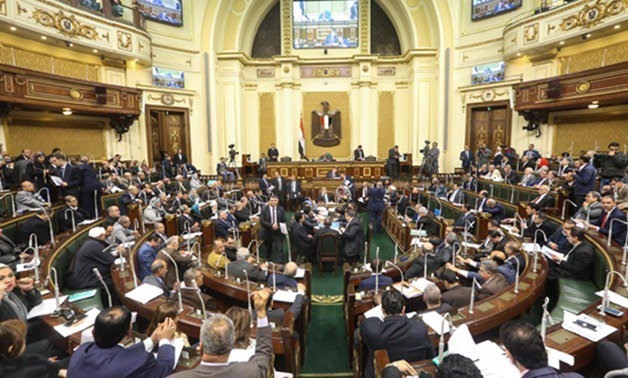
FILE - Egyptian parliamentarians hold talks
CAIRO – 23 April 2018: Parliament approved on Sunday the government-drafted law to amend some provisions in Agriculture Law No. 53 of 1966.
During the plenary session attended by the ministers of water resources and irrigation and agriculture, a plan to fairly distribute available water amongst agricultural crops was reviewed.
Article 1 in the Agriculture Law refers that the minister of agriculture shall determine the areas to cultivate certain crops, and shall ban other crops in certain areas. Hence, the draft law to amend Article 1 of the Agriculture Law stipulates that the minister of agriculture in coordination with the minister of irrigation shall issue a ministerial decree to ban the cultivation of some crops in certain areas that have low amounts of water, in order to rationalize water usage.
In the same context, the government agreed to amend Article 101 of the law, which stipulates those who violate the ministerial decrees issued to implement Articles 1, 2, 3, and 4 of the Agriculture Law shall be punished with a fine not less than LE 20,000, and not more than LE 50,000.
According to the amended Article 101, those who violate Articles 1, 2, 3, and 4 shall be punished by imprisonment for a period that does not exceed six months and a fine no less than LE 3,000 and no more than LE 20,000.
Water efficiency is considered one of Egypt's national security issues; the Nile River is the country’s most important water source.
The ancient Egyptian culture was built on the sides of the river; the Nile provides Egypt with 95 percent of its water. In 1902, 1906, 1929 and 1959, Cairo signed agreements with the Nile Basin countries which guarantee 55 billion cubic meters of Nile water per year for Egypt.
Egypt suffers from a water deficit of 30 billion cubic meters; it annually needs at least 90 billion cubic meters of water to cover the needs of 90 million citizens. However, it currently has only 60 billion cubic meters, of which 55.5 billion cubic meters comes from the Nile and just under five billion cubic meters comes from non-renewable subterranean water in the desert.
A further decrease in Egypt's water resources is expected amid the construction of the Grand Ethiopian Renaissance Dam (GERD), which could have a negative impact on Egypt’s Nile water share.
Despite the latest negotiations between Ethiopia, Egypt and Sudan to resolve the technical issues of the dam, Egypt is keen to look for new sources of water and to rationalize its usage to overcome any water scarcity problems in the future.
Agriculture in Egypt depends heavily on the Nile River, and it consumes 84 percent of Egypt’s water resources; therefore, the state is working on keeping its water security as much as it can through taking procedures that may help ration water.
The government starts with Agriculture to save water
The government has taken procedures aiming to ration water consumption through preventing the cultivation of certain crops that need large amounts of water.
Minister of Irrigation and Water Resources Mohamed Abdel Ati decided to reduce the rice agriculture area in Egypt from 1,700,000 feddans to 724,200 feddans (1 feddan = 1.038 acres). According to the ministry, this decline will save three billion cubic meters of water. At the same time, the ministry is working on launching campaigns to raise farmers’ awareness to reduce water usage.
On the other hand, some experts expect that reducing the rice cultivated areas will lead to a decrease in production, decrease the quantities offered in the markets and lead to higher prices and a trend towards imports to cover the needs of the local market to insure food security.
The Ministry of Agriculture has identified 53 varieties of strategic water-saving crops that are adapted to the different environment and climate conditions, focusing on breeding during the coming period, which included seven varieties of rice.
Additional Report by Rehab Ismail

Comments
Leave a Comment